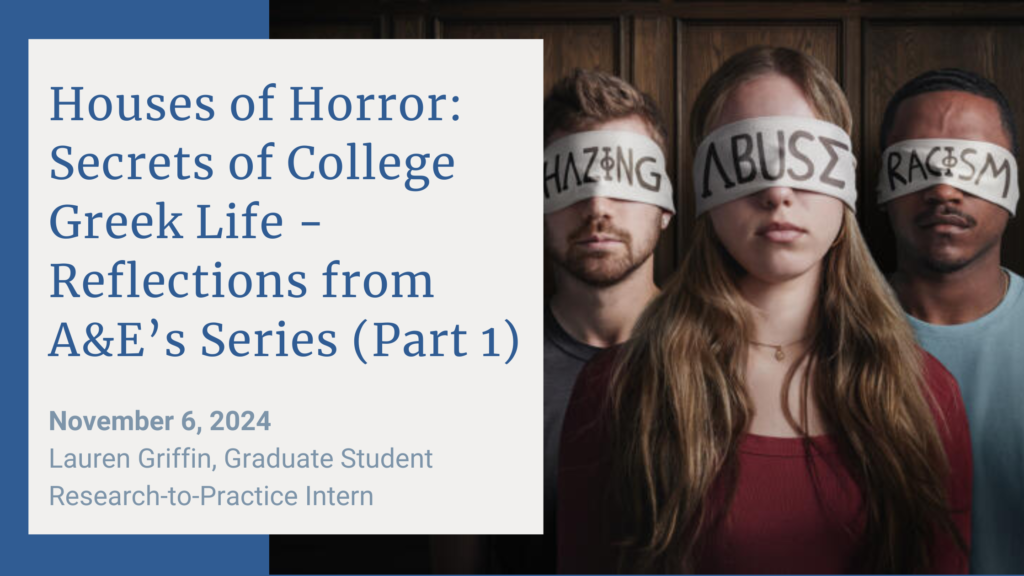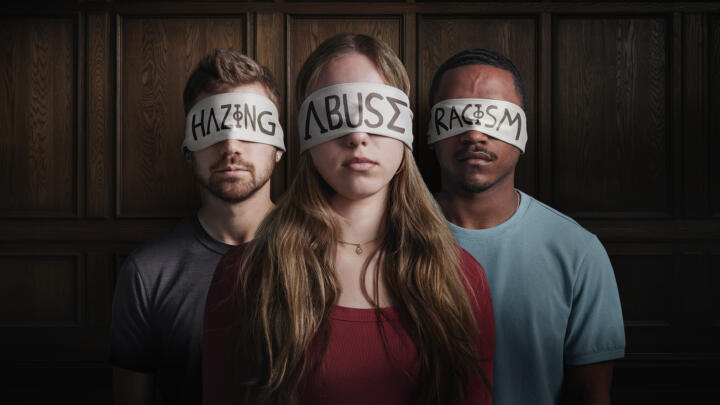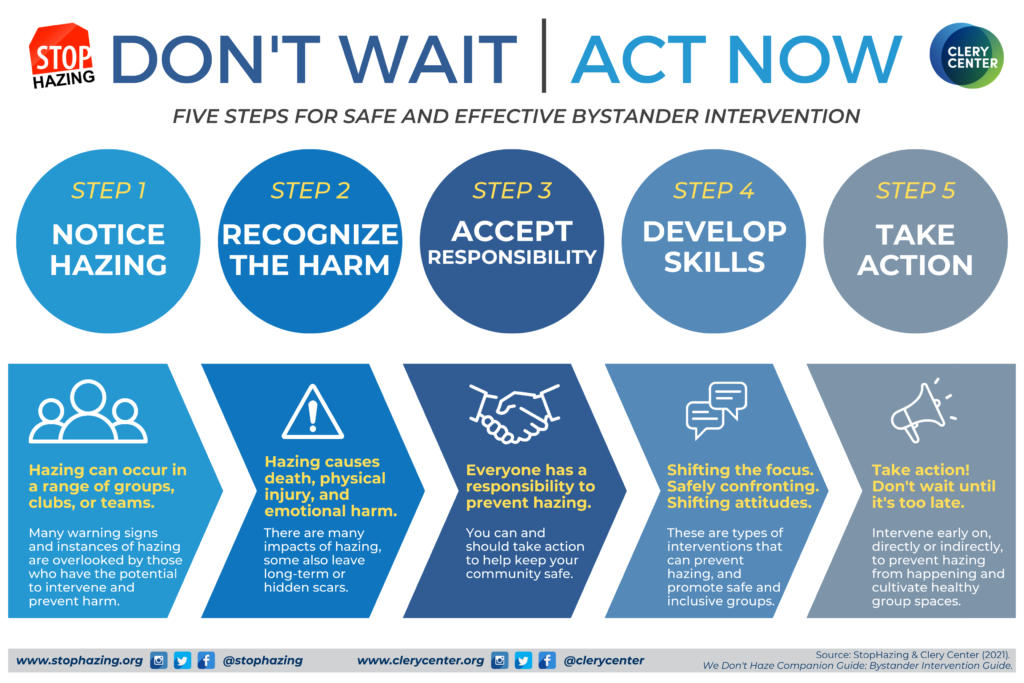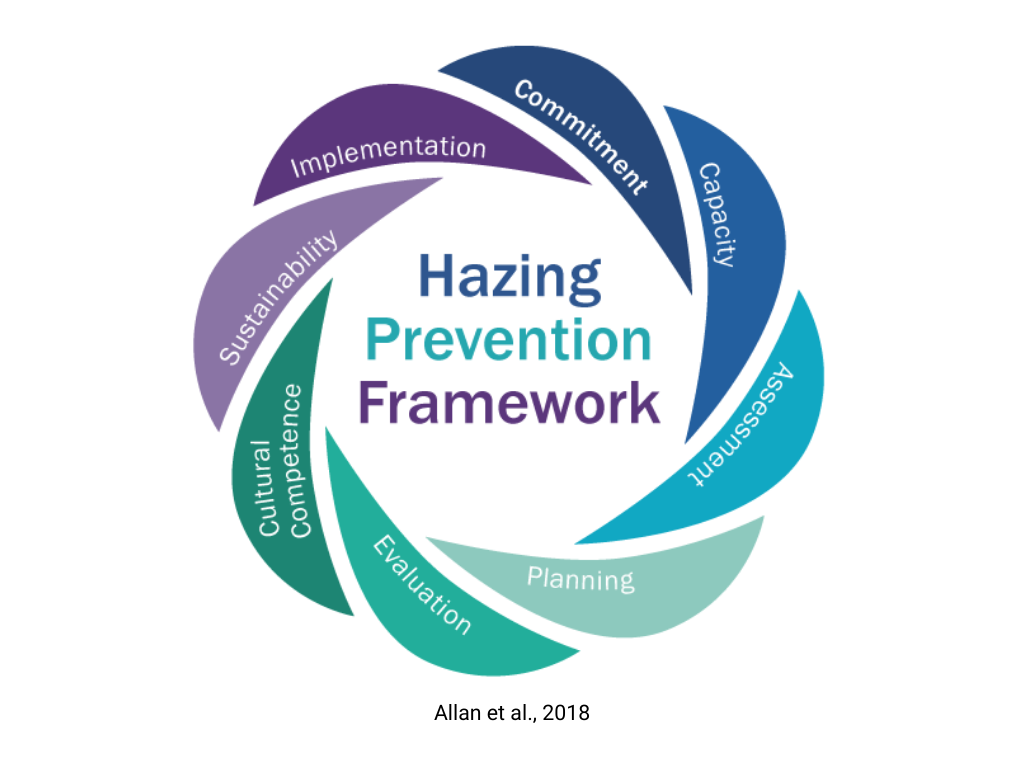Houses of Horror: Secrets of College Greek Life – Reflections from A&E’s Series

This post kicks off a series inspired by A&E’s powerful Houses of Horror: Secrets of College Greek Life. While this series specifically references fraternity and sorority life, it should be noted that hazing isn’t exclusive to fraternities and sororities- it’s an issue that extends to sports teams, clubs, and other groups. However, fraternity and sorority life stands out as the deadliest environments where hazing takes place, posing unique dangers for students.

While college Greek life often promises a sense of belonging and tradition when students go away to school, A&E’s six-part series, Houses of Horror: Secrets of College Greek Life, reveals a troubling underbelly.
The documentary shines a light on the impact of secrecy and power dynamics within these organizations, featuring exclusive interviews with former members, families, law enforcement, and experts. Through these firsthand accounts, the series exposes how hazing, substance abuse, sexual assault, and other dangerous behaviors can thrive within these groups.
The episodes recount harrowing incidents, from hazing deaths at California State University, Los Angeles and Pennsylvania “Penn” State University, to issues of racism and control within the notorious Machine at the University of Alabama. As the series unfolds, it challenges the prevailing image of Greek organizations, urging viewers to reconsider the value of tradition when it can jeopardize student safety and well-being.
One key takeaway from viewing the series is how secrecy and peer pressure fuel perilous hazing rituals. Hazing, rather than being a benign rite of passage, emerges as a harmful practice that has persisted for decades, largely unchecked. To effectively combat hazing, it’s essential to explore the forces that perpetuate it, understand the barriers to reporting, and empower bystanders to intervene.
Understanding Hazing and the Culture of Secrecy
Hazing is something most people have heard about but may not fully understand. In this section, we’ll define hazing and why it’s so hard to confront. By exploring its hidden dynamics and the silence that keeps it alive, we can start to see why it’s still an issue in so many groups.
What is Hazing?
Hazing is defined as “any activity expected of someone joining or participating in a group that humiliates, degrades, abuses, or endangers them, regardless of a person’s willingness to participate” (Allan & Madden, 2008). This harmful practice thrives on secrecy and a culture that discourages individuals from speaking out.
The Role of Peer Pressure and the Need for Belonging
Peer pressure and the deep-seated need to fit in play powerful roles in hazing. In this section, we’ll look at how peer pressure and the desire to belong fuel hazing, making it hard for members to step away even when they know something isn’t right.
A former pledge member in Episode 5: “Drowning in Secrets” reflects, “I knew if I decided to drop, my connections with my line sisters [would] ultimately be lost.” This statement reveals how the need for social connection can blind individuals to the dangers of their situation, trapping them in cycles of abuse.
The Power of Peer Pressure
Peer pressure is a powerful force in college settings, particularly within Greek organizations, where the desire to fit in can lead individuals to participate in or tolerate hazing practices. The experience of pledging a fraternity or sorority often creates a unique environment where loyalty to the group is paramount, and those who resist or challenge the status quo risk alienation. This pressure can manifest in various forms—whether through direct encouragement from older members or the implicit expectation that one must endure challenges to be accepted.
Pledges frequently find themselves in a paradoxical situation: they are torn between their instincts, which may tell them that the hazing is harmful, and the overwhelming need to belong to a group that promises camaraderie and lifelong friendships. The pressure to conform highlights the internal struggle of feeling compelled to participate in harmful or uncomfortable activities in order to prove one’s worth and maintain group acceptance, driven by the perception that others are doing the same. Power dynamics can pressure individuals into accepting harmful practices as normal, creating a cycle that perpetuates hazing and abuse.
The Need for Belonging
The allure of Greek life lies in its promise of belonging and community, yet this desire can lead individuals to accept behavior that undermines their dignity and safety. In a high-pressure environment, the fear of being ostracized or rejected can outweigh the risks associated with hazing – this is consistent with the National Study of College Student Hazing (2008) and reasons for not reporting hazing (see table 18).
A chilling comment from a pledge in Houses of Horror captures the prevailing mentality in Episode 1: “Binging to Belong”: “Leaving the pledge process makes it worse.” This mindset illustrates how hazing is often framed as a necessary step toward belonging, binding individuals to practices that can harm them.
Moreover, the social hierarchy within Greek organizations can exacerbate this dynamic. Older members often wield considerable influence, and pledges may feel compelled to earn their approval by enduring demeaning activities. This creates a culture where loyalty is equated with suffering, and questioning these practices is perceived as disloyalty.
Barriers to Reporting Hazing
While there are many documented reasons for why individuals don’t report hazing, in Houses of Horror, fear of retaliation and peer pressure from the group are common themes discussed.
Fear of Retaliation and Peer Pressure
The desire to fit in can lead individuals to accept hazing rather than report it. One pledge reflects in Episode 1: “Binging to Belong,” “As a pledge, you just have to think, everyone that’s doing this to you has been through the exact same thing. I’m going to lock in and get through this night.” This mindset reinforces the belief that enduring hazing is essential for acceptance. Older members often normalize abusive practices, making it difficult for pledges to challenge their treatment.
Michelle Guobadi, a featured voice in the documentary, articulates the power dynamics at play: “There’s definitely an imbalance of power with that. This is an older member. We’re trying to please that person and make sure we become members of that organization.” This highlights how hazing exploits hierarchies within Greek organizations, perpetuating abuse and creating an environment where reporting is fraught with risk.
Bystander Intervention and the Role of the Community
Stopping hazing relies not only on changing actions of those directly involved but also on empowering bystanders and the wider community to challenge harmful norms. Bystanders, often positioned to intervene, may stay silent out of fear of social backlash, highlighting the need for a supportive culture that encourages intervention.
The Role of Bystanders in Challenging Hazing
Bystanders play a crucial role in disrupting the cycle of hazing and abuse. In many cases, fellow members who witness hazing or other harmful behaviors are in a unique position to intervene. However, as highlighted in Houses of Horror, fear of social repercussions often silences these individuals. A bystander may hesitate to act, thinking, “What if I ruin my relationship with the older members or become a target myself?” This fear perpetuates the status quo, allowing hazing to continue unchecked (Allan & Stapleton, 2014).
The tragic death of Timothy Piazza is a powerful example of how the inaction of bystanders can have devastating consequences. After falling down the stairs during a fraternity event, Piazza lay in critical condition for hours while multiple fraternity members witnessed his suffering but failed to call for help. Their reluctance to intervene—likely driven by a fear of social backlash or protecting the group—illustrates the dangerous consequences of bystander inaction. In the Houses of Horror Episode 3: “Hazed to Death,” focuses on Piazza’s case and emphasizes how crucial bystander intervention could have saved his life had someone taken the initiative to seek medical attention sooner.
To effectively combat this issue, it’s essential to foster a culture where bystander intervention is not only encouraged but celebrated. Bystanders must be empowered with the tools and knowledge to recognize harmful behaviors and take action. Educational programs can play a vital role in this effort, equipping students with strategies to intervene safely. For instance, peer-led workshops on recognizing the signs of hazing and how to approach situations can create a sense of agency among bystanders.
Empowering Bystanders to Act
The narrative surrounding hazing often portrays it as an inevitability within Greek life, but this mindset can be shifted by empowering bystanders to challenge this notion. Bystanders need to understand that their silence contributes to a culture of complicity. As Kordel Davis notes in Episode 3: “Hazed to Death”, “It starts out slow. You don’t realize how bad it’s getting until you’re in too deep.” By increasing awareness around how these rituals can escalate, institutions can help bystanders feel more equipped to intervene before things reach a dangerous level.
As shown in the We Don’t Haze Bystander Intervention guide, bystander intervention is a powerful way to disrupt harmful behaviors and promote a safer environment for everyone involved. Learning to recognize hazing, understanding when to step in, and building the skills to do so safely are crucial steps. Whether supporting someone being hazed, speaking up when you see warning signs, or engaging others in conversations about positive group traditions, each action helps create a community where hazing is challenged, not ignored.

The Way Forward: Building a Culture That Rejects Hazing
Addressing hazing requires a comprehensive approach. Initiatives such as StopHazing’s Hazing Prevention Consortium provide the infrastructure for a campus-wide and comprehensive approach, guided by the Hazing Prevention Framework– the only research-based framework for campus hazing prevention to develop and implement effective prevention strategies. Institutions must educate students about the risks, hold organizations accountable, and support bystander intervention initiatives. By promoting a culture prioritizing safety and respect, we can create groups, clubs, teams, and organizations that provide meaningful connections without compromising well-being. Hazing is not a rite of passage; it’s a harmful tradition that has no place in today’s campus culture.
Call to Action
The documentary Houses of Horror: Secrets of College Greek Life serves as a stark reminder of the complexities within Greek Life, where the promise of community can sometimes mask dangerous behaviors. By understanding the dynamics of peer pressure and the critical role of bystanders, we can begin to dismantle the culture that allows hazing to persist. It is imperative for both individuals and institutions to take proactive steps toward creating a safer, more inclusive environment within Greek organizations, ensuring that the bonds formed through these experiences are built on mutual respect and care, not fear and suffering.
As we continue to explore the complexities of fraternity and sorority life, it’s essential to equip ourselves with the right tools to combat hazing and promote a culture of safety and respect. We invite you to check out our StopHazing resources, including these infographics and bystander intervention posters and the 10 Signs of Healthy & Unhealthy Groups toolkit and training, which shed light on how healthy and unhealthy behaviors can occur in group contexts. Additionally, be on the lookout for new Bystander Intervention resources from StopHazing, set to be released soon. These valuable materials are designed to empower you to recognize, respond to, and address hazing effectively.
Stay tuned for our next post, where we will dive deeper into the insights shared in the documentary Houses of Horror: Secrets of College Greek Life. We will discuss the culture of secrecy and tradition that can sometimes perpetuate harmful practices in fraternal organizations, emphasizing the importance of transparency and accountability in creating a safer environment for all members.
Guest writer: Lauren Griffin, Graduate Student and StopHazing Research-to-Practice Intern
Questions? Contact info@stophazing.org


